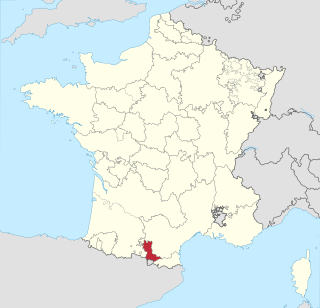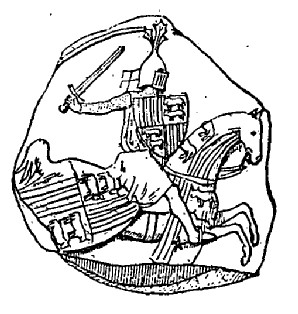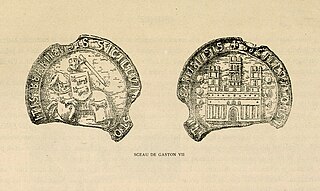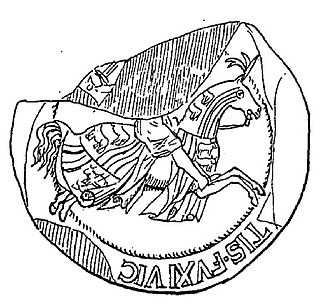
The County of Foix was a medieval fief in southern France, and later a province of France, whose territory corresponded roughly the eastern part of the modern département of Ariège.

Gaston IV was viscount of Béarn from 1090 to 1131. He was called le Croisé––the Crusader––because of his participation in the First Crusade as part of the army of Raymond of Saint-Gilles.

Gaston III, known as Gaston Phoebus or Fébus, was the eleventh Count of Foix and twenty-fourth Viscount of Béarn from 1343 until his death.

Gaston IV was the sovereign Viscount of Béarn and the Count of Foix and Bigorre in France from 1436 to 1472. He also held the viscounties of Marsan, Castelbon, Nébouzan, Villemeur and Lautrec and was, by virtue of the county of Foix, co-prince of Andorra. From 1447 he was also Viscount of Narbonne. Through his marriage to Eleanor, heiress of the Kingdom of Navarre, he also held the title of Prince of Navarre.

The viscounts of Béarn were the rulers of the viscounty of Béarn, located in the Pyrenees mountains and in the plain at their feet, in southwest France. Along with the three Basque provinces of Soule, Lower Navarre, and Labourd, as well as small parts of Gascony, it forms the current département of Pyrénées-Atlantiques (64).

Centule V, called the Young, was the Viscount of Béarn from 1058 to his death. Centule increased the autonomy of the viscounts of Béarn and distanced them from the dukes of Aquitaine, to whom they owed theoretical vassalage. Centule was also Count of Bigorre jure uxoris as Centule I.
Centule VI was a Viscount of Béarn. He was born into the House of Gascony, and served as viscount from 1131 to his death. Like his father, he was an ideal Christian prince for his age, ready to serve the Church in the Reconquista.
Talesa, Talèse, Talèze, or Ataresa was an Aragonese noblewoman and regent. She was the daughter of Sancho Ramírez, Count of Ribagorza, natural brother of King Sancho Ramírez of Aragon and Navarre, and member of the royal Jiménez dynasty. She married Gaston IV of Béarn and acted as regent of the viscounty of Béarn during his absences on Crusade in 1096-1101, and after his death for their son in 1131-1134 and her grandson until at least 1136.

Mary was a Viscountess of Béarn, Gabardan, and Brulhois from 1170 to 1171 in her own right.

Gaston VI (1173–1214), called the Good, was the Viscount of Béarn, Gabardan, and Brulhois from 1173. He was also Count of Bigorre and Viscount of Marsan through his marriage in 1196 to Petronilla, the daughter of Countess Stephanie-Beatrice of Bigorre.

The Viscounty, later Principalityof Béarn, was a medieval lordship in the far south of France, part of the Duchy of Gascony from the late ninth century. In 1347, the viscount declared Béarn an independent principality without feudal obligations. It later entered a personal union with the Kingdom of Navarre in 1479 and with France in 1589. In 1620, the prince formally incorporated Béarn as a province of France.
Centule III was the Count of Bigorre from 1163 until his death. He was the eldest son of Beatrice II and Peter of Marsan and succeeded his mother in Bigorre on her death.

Gaston II of Foix-Béarn, son of Gaston I of Foix-Béarn and Jeanne of Artois, was the 10th Count of Foix.

Gaston VII de Montcada, called Froissard, was the twentieth Viscount of Béarn from 1229. He was the son and heir of Guillermo II de Montcada of the House of Montcada and of Garsenda, daughter of Alfonso II of Provence and Garsenda of Forcalquier. He was succeeded by Roger-Bernard III of Foix.
Aymon II was the Count of Geneva from 1265. He was the son and heir of Count Rudolf, but died heirless himself and was succeeded by his brother Amadeus II. According to one modern historian, he was “overawed by the power of the count of Savoy”, and did little during his fifteen-year reign to recover the lands and jurisdictions lost to the Savoyards by his father and grandfather.
Petronilla of Bigorre or Petronilla of Comminges was ruling Countess of Bigorre between 1194 and 1251. She was the only child of Bernard IV, Count of Comminges, and his wife Stephanie-Beatrice IV, Countess of Bigorre. Petronilla succeeded her mother in 1194 as Countess of Bigorre; she was also Viscountess of Marsan and Nébouzan through further successions. She reigned as countess for fifty-seven years, in which time she was married five times.

Gaston I of Foix or Gaston VIII of Foix-Béarn was the 9th Count of Foix, the 22nd Viscount of Béarn and Co-Prince of Andorra.
Martha of Marsan was a ruling Viscountess of Marsan. She was suo jure Viscountess of Marsan, which she inherited from her father.
Constance was suo jure Viscountess of Marsan as well as titular Countess of Bigorre, daughter of Gaston VII, Viscount of Béarn and his first wife Martha of Marsan. Constance inherited all of her titles from her mother and contended to inherit her father's Viscounty of Béarn. She was married three times during her lifetime, marrying into the royal families of Aragon, Castile and England.

Margaret of Béarn – also known as Margaret or Margueriteof Montcada was a noblewoman, who ruled lands near the Pyrenees mountains and in the southwestern part of present-day France. When her father died in 1290, she inherited the lands, assets and title, Viscountess of Béarn. In 1310 following the death of her sister, she inherited the assets and title of Countess of Bigorre.